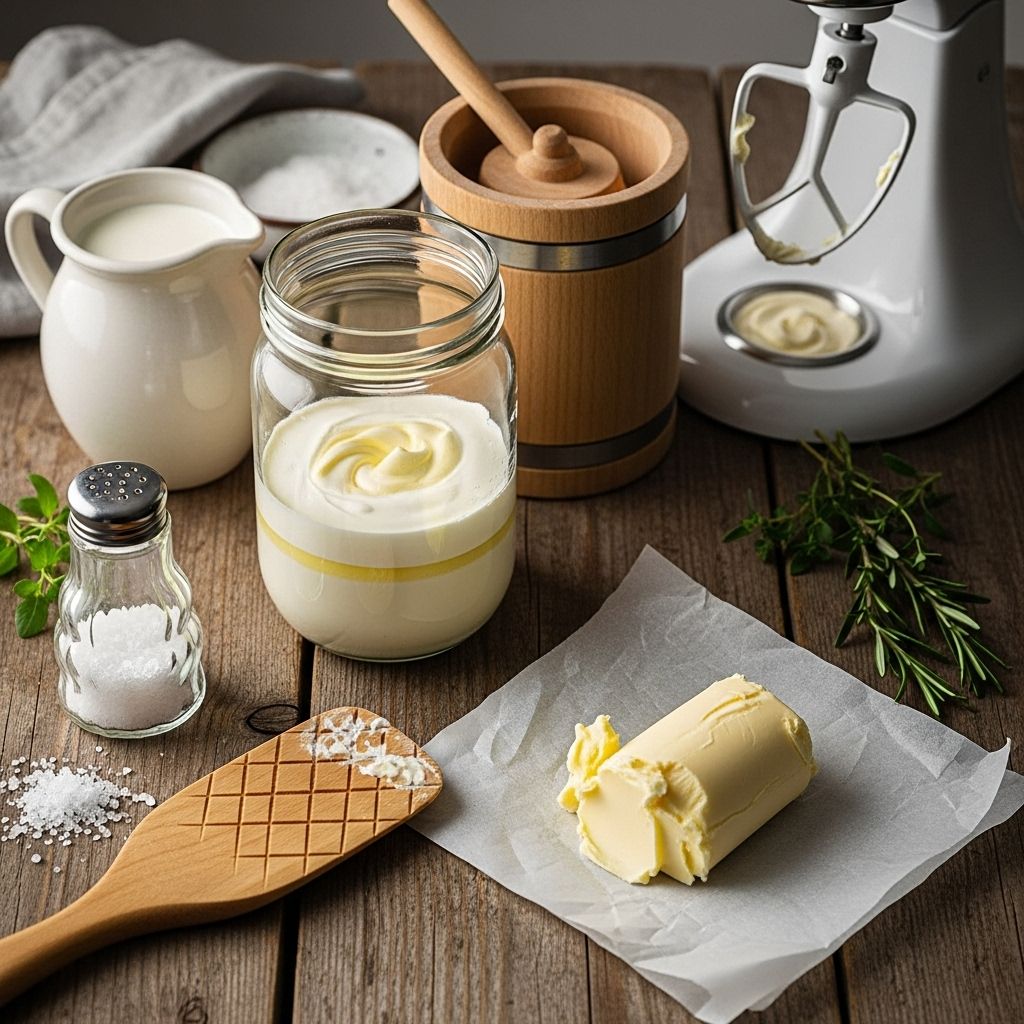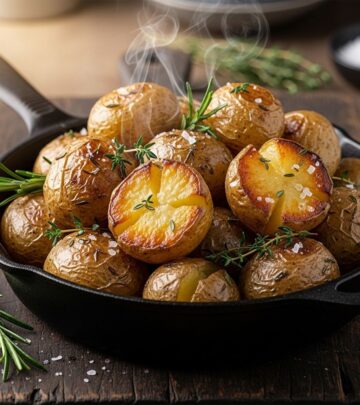How To Make Butter In 6 Easy Steps: Fresh Homemade Guide
Discover the simple joy of making fresh, creamy butter at home with easy steps, expert tips, serving ideas, and answers to popular questions.

Image: HearthJunction Design Team
Homemade Butter: A Complete Guide to Fresh, Creamy Butter in Your Kitchen
Making homemade butter is a rewarding, easy, and surprisingly quick process that transforms heavy cream into a rich, creamy spread bursting with fresh flavor. Whether you’re looking for a classic butter for breads, a base for creative flavored varieties, or simply a fun kitchen project, this guide walks you through every step, shares tips for perfect results, and answers your top questions.
Why Make Homemade Butter?
There’s something magical about churning your own butter. The taste is unmatched—mildly sweet, creamy, and customizable. Homemade butter is free from preservatives, can be salted or unsalted to taste, and allows you to experiment with herbs, spices, or even sweet variations. The process is also a great hands-on learning experience for kids and adults alike.
- Freshness: Enjoy incredibly fresh, pure butter.
- Customization: Adjust salt, add herbs, or blend in flavors.
- Simple Ingredients: All you need is heavy cream (and optional salt).
- Fun & Educational: Watch science in action as liquid cream turns solid.
Ingredients for Homemade Butter
- Heavy cream (whipping cream), chilled
- Salt (optional, for seasoning)
Tip: For the richest flavor, use a high-quality heavy cream with no additives. Organic or local dairy cream yields an especially delicious result.
Equipment You’ll Need
- Food processor, stand mixer, or blender
- Fine mesh strainer or cheesecloth
- Small bowl
- Wooden spoon or silicone spatula
- Cold water (for rinsing)
Step-by-Step Directions: How to Make Homemade Butter
- Pour the Cream:
- Add cold heavy cream to your food processor, stand mixer (with whisk attachment), or blender. Do not fill above halfway, as the cream needs room to expand and whip.
- Whip the Cream:
- Start processing on high speed. First, the cream will thicken into whipped cream. Continue processing—the fat will eventually separate, and you’ll see clumps of butter in a thin, milky liquid (buttermilk).
While you’re enjoying the homemade butter, why not explore another fantastic kitchen staple? Ghee is a wonderfully versatile and deeply flavorful fat that can enhance many dishes. Our guide will take you through the simple process of making ghee at home, ensuring that you unlock its rich, nutty flavor. Ready to diversify your kitchen skills? Learn the secrets behind homemade ghee by checking out our step-by-step guide to making ghee. - Separate the Butter and Buttermilk:
- Once the butter solidifies and the buttermilk separates, pour the contents through a fine mesh strainer or cheesecloth. Reserve the buttermilk for baking or pancakes!
- Wash the Butter:
- Rinse the butter under cold water, kneading gently with a spoon or spatula to wash away any residual buttermilk. Repeat until the water runs clear—this step ensures your butter stays fresh longer.
- Season (Optional):
- Transfer butter to a bowl and press with a spoon to remove any last drops of water. Sprinkle with salt to taste if desired, and mix thoroughly.
- Shape and Store:
- Shape butter into a ball, block, or press into a butter mold. Cover and refrigerate. Enjoy immediately or store for later use.
Quick Reference Table: Homemade Butter Steps
| Step | Description | Time Estimate |
|---|---|---|
| Pour Heavy Cream | Add to mixing device of choice | 1 min |
| Process/Whip | Beat cream until fat separates | 7–10 min |
| Strain and Rinse | Separate buttermilk and rinse under cold water | 3–5 min |
| Season & Shape | Salt, knead, and form as desired | 2–3 min |
Tips for Perfect Homemade Butter
- Use cold cream: Yields better texture and separates more quickly.
- Don’t overfill the processor: The cream needs space to whip and expand.
- Rinse thoroughly: Removing all buttermilk helps preserve your butter and prevents spoilage.
- Work quickly: Especially in a warm kitchen, butter can become too soft. If this happens, briefly refrigerate and continue.
- Salt to taste: Start with a pinch and adjust—too much can overpower the delicate flavor.
- Save the buttermilk: Fresh buttermilk is great in pancakes, biscuits, or marinades.
Flavor Variations: Make It Your Own
Once you’ve mastered classic unsalted or salted butter, try one or more of these creative flavorings. Mix in after rinsing, before shaping:
- Herb Butter: Add chopped fresh herbs like parsley, dill, chives, or rosemary.
- Garlic Butter: Mix in minced garlic (raw or roasted) and a pinch of black pepper.
- Honey Butter: Blend with a drizzle of honey and a touch of cinnamon for breakfast treats.
- Lemon Zest: Add finely grated lemon zest—delicious with seafood or vegetables.
- Spiced Butter: Stir in ground spices like smoked paprika, chili flakes, or curry powder for a unique twist.
Ways to Use Homemade Butter
- Spread on warm bread, biscuits, scones, or muffins
- Melt over grilled vegetables, steaks, or roasted chicken
- Bake into cookies, cakes, or pastries
- Stir into mashed potatoes or cooked grains
- Finish off fresh corn, steamed greens, or scrambled eggs
Storing and Shelf Life
Homemade butter is best enjoyed fresh but can be kept refrigerated in an airtight container for up to two weeks. For longer storage, wrap tightly and freeze for up to three months. Label with date and any added flavors for easy reference.
- Refrigeration: Up to 2 weeks in a sealed container
- Freezing: Up to 3 months; thaw in the refrigerator before use
- Tip: Unsalted butter has a shorter shelf life than salted. Freezing is best for unsalted varieties.
Frequently Asked Questions (FAQs)
Can I use a mason jar instead of a food processor?
Absolutely. Pour the cream into a clean jar with a tight-fitting lid and shake vigorously until the solids separate. It takes longer (15–20 minutes), but it’s a fun, hands-on project and requires no electricity.
What’s the difference between cultured and sweet cream butter?
Sweet cream butter is made from fresh sweet cream, as in this recipe. Cultured butter is made from cream that has been fermented with live cultures before churning, which results in a tangier, more complex flavor.
What can I do with the leftover buttermilk?
The liquid left after making butter is traditional buttermilk—perfect for pancakes, scones, biscuits, or even marinating chicken. Store it in the fridge for up to three days.
Can I make butter with light cream or milk?
Only heavy cream (whipping cream) has enough fat content (at least 35%) to separate into butter and buttermilk. Milk or light cream will not work for homemade butter.
How can I make my butter softer for spreading?
Let the butter sit at room temperature for about 30 minutes before serving. For whipped butter, beat the finished butter with a small amount of cream or milk until fluffy.
Is homemade butter healthier than store-bought?
Homemade butter allows you to control the ingredients and avoid additives or preservatives. While it is still high in fat, using fresh, quality cream can make a difference in flavor and, depending on the cream source, nutrition.
Pro Tips for Success
- For easiest cleanup, use a stand mixer with a splash guard.
- Add salt slowly; you can always add more, but it’s hard to take away.
- Get creative with molds or shape butter into logs and wrap in parchment for a pretty gift.
- Make a double batch and freeze half to always have homemade butter on hand.
Nutrition Information (per serving, estimated)
| Nutrient | Amount |
|---|---|
| Calories | 100 |
| Fat | 11g |
| Saturated Fat | 7g |
| Cholesterol | 30mg |
| Sodium (unsalted/salted) | 0mg / 90mg |
Note: Actual values may vary depending on the cream and any added flavorings.
Final Thoughts
Making homemade butter is a simple pleasure that connects you to kitchen traditions of the past, delivers incredible taste, and adds a touch of homemade luxury to any meal. Try it for yourself and experience the difference fresh butter can make!
References
Read full bio of Srija Burman












